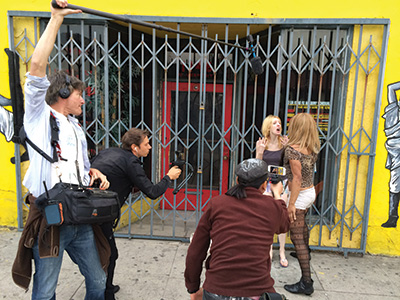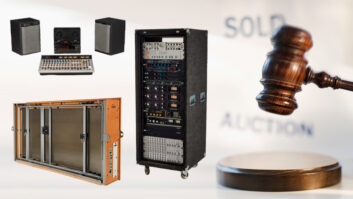
At 6-foot 5-inches, squeezing into the trunk of a car is no easy task, and adding 40 pounds of recording equipment and a boom pole definitely doesn’t make it any easier. But why would anyone put themselves through that kind of torture? To get the shot, of course.
“You just sort of grin and bear it because the story has to be told,” says sound mixer Irin Strauss of his recent outing on director Sean Baker’s indie-film Tangerine. “Sean [Baker] has a gift for storytelling that is completely unique. He has this uncanny ability to bring heart to dark social situations.”
Tangerine is a dark comedy about transgender sex worker Sin-Dee Rella (played by Kitana Rodriguez) in search of her cheating boyfriend/pimp one Christmas Eve in Hollywood. Sin-Dee is joined by best friend Alexandra (Mya Taylor), also a trans sex worker, but their paths diverge as they attend to their own agendas. All the characters eventually come together in a climatic brouhaha at Donut Time.
Having worked on Baker’s previous film Starlet (2012), Strauss had a good idea of what to expect on Tangerine—like filming with a skeleton crew, shooting clandestinely on location, and even stealing shots at locations without a permit. “Sean doesn’t like to call too much attention to himself, and he gets away with it,” Strauss says. “He’s really big into social realism and shooting people in their natural surroundings.”
As it turns out, the filming situation on Tangerine was more severe in some respects. The crew was even smaller than Starlet’s, and Tangerine was shot, rather inconspicuously, on iPhone 5s. “The whole idea with Tangerine was to keep a low profile. I felt like I was going to stick out like a sore thumb because I am carrying all this gear, and I’m so tall, and I have a boom pole,” says Strauss. “I hid around corners and inside cars to avoid calling attention to myself and our crew.”
In choosing a stealthy setup for Tangerine, Strauss selected the Sound Devices 664 portable production mixer/recorder, which he’s used often on documentaries and as a backup recorder on narratives. “It’s relatively light for most professional recorders,” notes Strauss. He also carried a Schoeps CMIT5U shotgun microphone, a Schoeps CMC 4U with a hypercardioid and a cardioid capsule, eight Sanken COS-11D lavaliers paired with Lectrosonics SMV wireless transmitters, and Sanken CUB-01 boundary mics as stash mics when the lavs and boom weren’t enough. His total kit weighed in at 40 pounds. That’s still a lot to haul around when chasing after camera guys with iPhones for 18 hours a day.
“We wanted to shoot it in 22 days,” Strauss says. “We were scrambling around Hollywood, shooting nonstop except to go to bed at night. It was relentless. After the first week I was completely spent. I believe the experience took 10 years off my life!”
As for the film’s climactic scene at Donut Time, Strauss notes it was sheer chaos. Baker relied on Strauss to capture every line, because with everyone shouting over each other, it was impossible to hear it all as it was happening. “We had consultations about who said what and when, to make sure we had all the dialog gems,” says Strauss.
Filming at Donut Time was no cakewalk. The store was still in business during the shoot, even with the entire cast of characters and film crew present. “It became really stressful on the crew, and there was a lot of pressure to get it done and get it right. But we pulled it off,” says Strauss. “Thank goodness for having years of documentary and narrative experience. My abilities were well-suited to the project.”
POST SOUND
At Sound Logic Post supervising sound editor/re-recording mixer Jeremy Grody was holding his breath in anticipation of receiving a film shot on iPhones. “When Sean said it was shot on a series of iPhones, my first thought was, ‘What has my career come to?’ And after seeing a rough cut, I thought this was going to be an utter mess,” admits Grody. “But then it showed up in widescreen and I just couldn’t believe it.” Grody breathed a huge sigh of relief when he heard the production tracks for the first time. “I was really so pleasantly surprised at how good the production tracks were. Irin Strauss is a pro, and he did an absolutely fabulous job on the movie.”
(NOTE: All three of Baker’s iPhone 5s smartphones sported a few upgrades, like a 1.33x Anamorphic Adapter Lens by Moondog Labs and the FiLMiC Pro app, which allowed them to shoot in widescreen at a higher-resolution than the standard smartphone camera. Additionally, the crew used Steadicams with iPhone mounts.)

With only two-and-a-half weeks to complete the design, edit and 5.1 mix in time for the Sundance Film Festival, Grody tapped sound supervisor Trevor Jolly to help cut the production tracks. “Trevor knows exactly how to prep tracks in the most useful way,” says Grody. In particular, Jolly cut the climactic scene in Donut Time where all the characters have it out. “That scene is a really good example of Irin’s coverage. All the characters’ lines are overlapping, but since we had separate lav mics for everyone, Trevor was able to edit them in a way that only required us to do a minimal amount of ADR. That scene is predominantly production dialog.”
Even though Grody prefers the sound of a good, clean boom mic track, he opted for the lavs on Tangerine. “The characters would literally take off in opposite directions. With that run-and-gun style, the lav mics enabled the coverage of this movie to work,” Grody explains. “The boom mic was often way too reverb-y, or way too noisy, especially when they were out on the street.” Because lav mics tend to sound too close-up, Grody used EQ and reverb to put the dialog more naturally into the environment. “The goal being that, when I’m done with those lav mics, it sounds like a boom mic.” Grody may even have fooled Strauss into believing the dialog in the film is coming from the boom mic. “Irin [Strauss] might not be aware that I used so much of the lav mics in this film. That’s good because I want the lavs to sound like a rich boom mic.”
For sound design, Baker wanted to accentuate the intensity and danger of living and walking the streets in Hollywood. Grody covered every car-by and added walla of background people to emphasize the feeling of street life. Foley mixer/editor Matt Manselle and Foley artist Brian Straub also contributed key sound elements in time for the Sundance mix. “Brian [Straub] did the fabulous Sin-Dee footsteps in heels, which Sean and I knew were going to be a prominent sound, as she blasts through the streets of Hollywood to find the girl she’s after,” says Grody.
In Grody’s approach to mixing, every mix move is made with the story in mind. “If you stay focused on the story, and you are always aware of the emotional content of what’s happening on the screen, the appropriate mix decisions will follow,” says Grody. For example, the addition of a pronounced slap reverb on Sin-Dee’s lines, as she’s yelling across the parking lot at Alexandra, helps communicate her aggression. Sin-Dee’s yelling is so loud that her voice is bouncing off the surrounding buildings. “During review sessions of the 5.1 mix, Sean and I egged each other on, and I think the resulting mix and music score reflect the pulsating, frenetic energy of Tangerine.”
Grody edited and mixed Tangerine on a Pro Tools HDX system in conjunction with a three-pack of Euphonix/Avid Artist Series control surfaces. His studio uses Tannoy System 1000 monitors for LCR, a Tannoy subwoofer, and JBL 8320s for surround. “The real key to mixing films on a smaller stage, like mine, is to have a room that’s tuned to the Dolby specification. What you hear on the small stage will reasonably translate in a movie theater,” states Grody.
After the frantic finish for Sundance, Grody did an additional two weeks of work on Tangerine, addressing tweaks for the director, plus building out the full M&E, which includes additional sound editorial, additional Foley by Manselle and Straub, and M&E mixes.
“Once you commit to a job, there are no excuses. It’s really important to not let the budget become an excuse to do less. My philosophy is you always give 110 percent, because you never know what could happen with that project,” says Grody. “Three years ago, I was mixing on one of the most expensive stages in town at Sony Pictures, and now I mixed a movie that was shot on an iPhone. But if it’s good art, then it does not matter. If it’s good storytelling, then it does not matter. And in the hands of the right person, it does not matter. And Sean Baker is, quite literally, the right person. He’s a fabulous storyteller and a fabulous filmmaker.”







